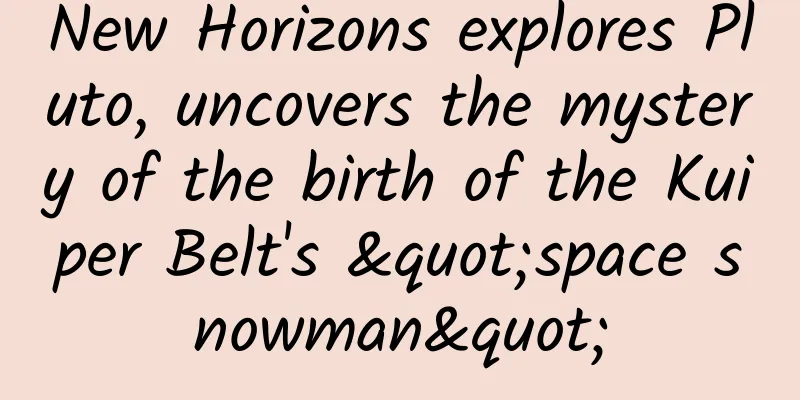New Horizons explores Pluto, uncovers the mystery of the birth of the Kuiper Belt's "space snowman"

|
The most distant object ever photographed in the Solar System, the new study provides new clues about the formation of Kuiper Belt Objects, asteroid-like objects at the edge of the Solar System, and helps understand the early stages of the formation of the Solar System. In the new study published in the journal Nature, the unique features of Arrokoth, which was first photographed last year by NASA's New Horizons space mission, are explained. The story begins in 2006, when the New Horizons spacecraft was sent to take the first close-up images of Pluto and study its features and topography. After launch, New Horizons fixed its orbit to Pluto and began a long journey of nine years. In order not to waste fuel and resources, most of its systems were in hibernation mode until it approached its target Pluto. It was also in 2006 that the International Astronomical Union decided to downgrade Pluto from planet status to a dwarf planet. In short, the New Horizons spacecraft was sent to study a planet, fell asleep, and woke up to find that Pluto, once one of the nine planets in the solar system, is no longer considered a planet. Journey to Pluto But that doesn't detract from the mission's importance. New Horizons provided spectacular images of Pluto and its moon Charon, and delivered valuable scientific information that is still being studied and will likely be studied for years. These studies will provide important information for understanding the formation of the solar system, and in particular the formation of the Kuiper Belt. But there's more to New Horizons' adventure. While Pluto is the largest and most distant object in the solar system, it's not the only one. Beyond Neptune is a region called the Kuiper Belt, which is made up of countless asteroid-like objects ranging in size from a few feet to thousands of miles across. Conditions in this region are different from those in its "sister" asteroid belt within the Solar System (in particular, it is much colder), and Kuiper Belt objects generally consist of more icy material. The New Horizons spacecraft is equipped with enough resources to observe another Kuiper Belt object, if such an object can be found and is not too far from the spacecraft's original orbit. On June 26, 2014, after extensive observations of such objects, the Hubble Space Telescope discovered one of them. Following its confirmation, the New Horizons team designed the spacecraft's trajectory so that, after completing its mission of mapping Pluto, it will pass next to the newly discovered object. Journey of Discovery New Horizons passed by the object five years later (and four years after the 2015 encounter with Pluto), and humans first imaged the small Kuiper Belt object up close on January 1, 2019, when the New Horizons spacecraft passed by from about 3,500 miles away. After the first images arrived, the Kuiper Belt object, known as 2014-69, was nicknamed "The Snowman" for its unique appearance. New Horizons researchers originally called it Ultima Thule (Latin for "edge of the world") because of its remote location at the edge of the solar system. But the object was eventually renamed Arrokoth 486958, which means "sky" or "cloud" in the now-extinct Powhatan Aboriginal language. New Horizons has gathered a wealth of information about Yeti: it is a 30-kilometer-long contact binary with two lobes of different sizes connected to each other by a thin neck, and appears to be the product of the collision of two smaller Kuiper Belt objects to form Arrokoth. Although various models have been proposed to explain the formation and special properties of Arrokoth, these models have encountered major challenges and cannot well explain important features of Yeti, especially its own slow rotation rate and large inclination. The researchers present novel analytical calculations and detailed simulations that explain the formation and characteristics of Arrokoth. The study was led by PhD student Evgeni Grishin, postdoc Dr. Uri Malamud and their supervisor Professor Hagai Perets in collaboration with the research group in Tübingen, Germany. A simple high-speed collision between two random objects in the Kuiper Belt would have shattered them, as they are most likely composed mainly of soft ice. On the other hand, if the two objects were moving in circular orbits (similar to the orbit of the Moon around the Earth), the collision would have caused the two objects to be pulverized. Dissecting the Snowman Then slowly spinning down to more gently approach each other and make contact, Arrokoth's rotation speed would be very high, while the measured speed is actually quite low relative to such expectations. A full rotation of Arrokoth takes 15.92 hours. In addition, its inclination (relative to the plane of its orbit around the Sun) is very large, reaching 98 degrees, so it lies almost on its side. According to the research model, the two celestial bodies rotate around each other, but because they rotate around the Sun together, they basically form a triple system. The dynamics of such triple star systems are complex and are known as the three-body problem. The dynamics of a gravitational triple star system is known to be very chaotic, and in the study, the researchers found that the system does not move in a simple, orderly way, but also does not behave in a completely chaotic way. Through slow (long-term) evolution, it goes from a wide, relatively circular orbit to a highly eccentric, elliptical orbit, which is much slower than the orbital period of Arrokoth around the Sun. It can be shown that such a trajectory will eventually lead to a collision, and on the one hand the collision will be slow. "But on the other hand, a slowly rotating, highly tilted object would be produced, which is consistent with the properties of Arrokoth. Detailed simulations confirmed this and produced models that are very similar to the Arrokoth snowman in appearance, rotation and tilt. We also studied the stability and likelihood of such processes and found that they are quite common in up to 20% of all Kuiper Belt-wide binaries and may evolve in a similar way. Until now, it has not been possible to explain the unique features of Arrokoth, which is a counterintuitive result." "The probability of a collision actually increases as the initial binary is at a greater distance and the initial inclination is closer to 90 degrees. The new model explains both the high probability of a collision and the unique data for today's unified system, and actually predicts that there will be more objects in the Kuiper Belt. In fact, even the system of Pluto and the satellite Charon may have formed through a similar process, and they appear to play an important role in the evolution of binary and lunar systems in the Solar System." Boco Park | Research/Source: American Institute of Technology Reference journal Nature BoKeYuan|Science, technology, research, popular science Follow [Bokeyuan] to see more beautiful cosmic science |
<<: Why is it so difficult to achieve "Internet freedom" at an altitude of 10,000 meters?
>>: "Iron Lung Man": Living in an Iron Can, Power Outage Means Death
Recommend
You can buy a good-looking mid-size car for 100,000 yuan. Perhaps this was the dream of the early rise of domestic brands.
In the process of commodity trading, there has al...
Information flow promotion is ineffective. Are you using the correct copywriting scenarios?
Today a friend sent me an h5, which is about a ne...
What to do if the retention rate of the live broadcast room is low? How to improve the retention rate of live broadcast room
I believe that many new anchors have faced such a...
Why are brands rushing to collaborate across industries?
1. Conclusion I’m afraid you’ll think I’m being t...
Can sleep-aiding aromatherapy really cure insomnia? Don’t believe it anymore, because…
“Sleep-aiding aromatherapy can cure insomnia.” Th...
Data Operations: How to define “user retention” and “activity”?
1. Active Users Let’s first define active users: ...
11 advertising and marketing economics theories!
Why do marketers need to have some basic knowledg...
After 23 years of water conservation, a "Tianshan Lake" has been created here!
The beautiful Tianshan Mountains nourish all thin...
The most "romantic" plant in history is actually this!
Autumn and Winter The golden ginkgo is unique in ...
How the Green Giant of Carbon Storage Can Resist an Unstable Climate System
Recently, my country has been affected by strong ...
Why are girls’ abdominal muscles called vest lines?
What Dongdong Miao envies most is people with abd...
Some scientists not only don't take a holiday, but are also ready to tell you about a discovery that took them ten years to develop.
Author: Liu Yun, Wang Bo, Shi Gongle (Nanjing Ins...
Home central air conditioning is a tough nut to crack
From the perspective of home air conditioner manu...
Metaverse, the next marketing trend!
Yesterday we talked about Facebook changing its n...
What is the specific list of closed communities in Shanghai in 2022? Attached is the latest list of quarantine communities!
Recently, the local epidemic in Shanghai has attr...









